
Concept explainers
Draw the products formed when each diene is treated with one equivalent of
a.  b.
b.  c.
c.  d.
d. 
(a)
Interpretation: The product formed by the reaction of given diene with one equivalent of
Concept introduction: Diene is a hydrocarbon that contains two
Answer to Problem 16.16P
The product formed by the reaction of given diene with one equivalent of

Explanation of Solution
Conjugated dienes undergoes electrophilic addition to gives a mixture of products that is
Markovnikov addition of
The given diene is shown below.

Figure 1
The given diene is a conjugated diene. The attack of

Figure 2
In the next step, chlorine as a nucleophile will attack on the carbocation to give constitutional isomers. Thus, the product formed by the reaction of given diene with one equivalent of
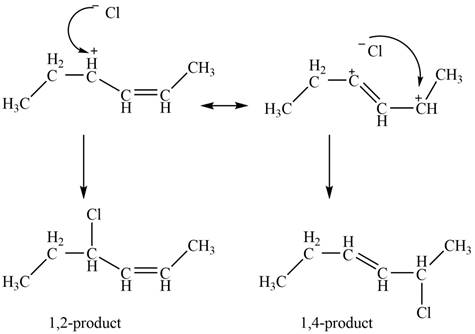
Figure 3
The product formed by the reaction of given diene with one equivalent of
(b)
Interpretation: The product formed by the reaction of given diene with one equivalent of
Concept introduction: Diene is a hydrocarbon that contains two
Answer to Problem 16.16P
The product formed by the reaction of given diene with one equivalent of
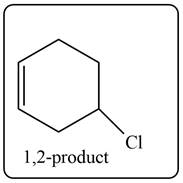
Explanation of Solution
Conjugated dienes undergoes electrophilic addition to gives a mixture of products that is
Markovnikov’s rule states that the positive part of acid attached to that carbon atom in
The given diene is shown below.
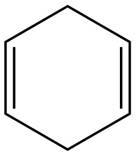
Figure 4
The given diene is an isolated diene. The attack of

Figure 5
In the next step, chlorine as a nucleophile will attack on the carbocation to form desired product. Thus, the product formed by the reaction of given diene with one equivalent of
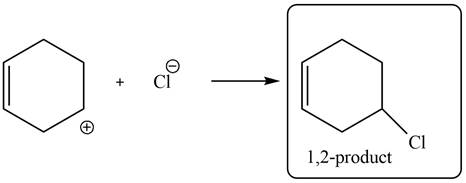
Figure 6
The product formed by the reaction of given diene with one equivalent of
(c)
Interpretation: The product formed by the reaction of given diene with one equivalent of
Concept introduction: Diene is a hydrocarbon that contains two
Answer to Problem 16.16P
The product formed by the reaction of given diene with one equivalent of
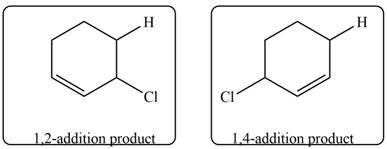
Explanation of Solution
Conjugated dienes undergoes electrophilic addition to gives a mixture of products that is
Markovnikov addition of
The given diene is shown below.
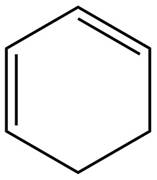
Figure 7
The given diene is a conjugated diene. The attack of
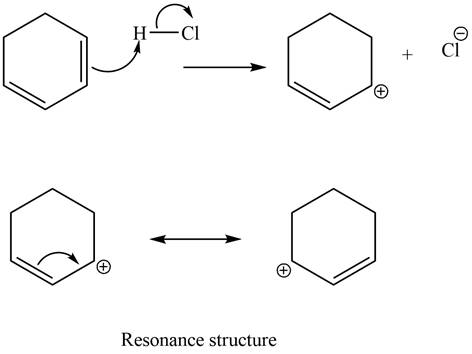
Figure 8
In the next step, chlorine as a nucleophile will attack on the carbocation to give constitutional isomers. Thus, the product formed by the reaction of given diene with one equivalent of
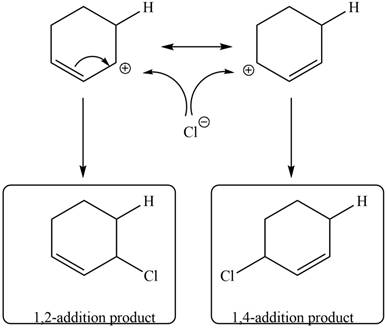
Figure 9
The product formed by the reaction of given diene with one equivalent of
(d)
Interpretation: The product formed by the reaction of given diene with one equivalent of
Concept introduction: Diene is a hydrocarbon that contains two
Answer to Problem 16.16P
The product formed by the reaction of given diene with one equivalent of

Explanation of Solution
Conjugated dienes undergoes electrophilic addition to gives a mixture of products that is
Markovnikov addition of
The given diene is shown below.
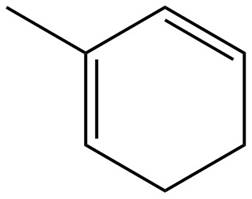
Figure 10
The given diene is a conjugated diene. The attack of
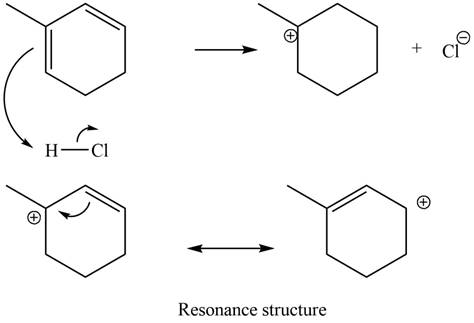
Figure 11
In the next step, chlorine as a nucleophile will attack on the carbocation to give constitutional isomers. Thus, the product formed by the reaction of given diene with one equivalent of
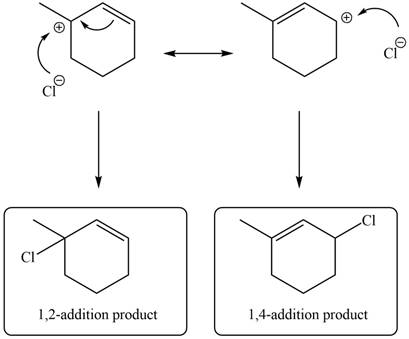
Figure 12
The product formed by the reaction of given diene with one equivalent of
Want to see more full solutions like this?
Chapter 16 Solutions
ORGANIC CHEMISTRY
- What is the final product when D-galactose reacts with hydroxylamine?arrow_forwardIndicate the formula of the product obtained by reacting methyl 5-chloro-5-oxopentanoate with 1 mole of 4-penten-1-ylmagnesium bromide.arrow_forwardIn the two chair conformations of glucose, the most stable is the one with all the OH groups in the equatorial position. Is this correct?arrow_forward
- please help me with my homeworkarrow_forwardhelparrow_forwardThe temperature on a sample of pure X held at 1.25 atm and -54. °C is increased until the sample boils. The temperature is then held constant and the pressure is decreased by 0.42 atm. On the phase diagram below draw a path that shows this set of changes. pressure (atm) 2 0 0 200 400 temperature (K) Xarrow_forward
- QUESTION: Answer Question 5: 'Calculating standard error of regression' STEP 1 by filling in all the empty green boxes *The values are all provided in the photo attached*arrow_forwardpressure (atm) 3 The pressure on a sample of pure X held at 47. °C and 0.88 atm is increased until the sample condenses. The pressure is then held constant and the temperature is decreased by 82. °C. On the phase diagram below draw a path that shows this set of changes. 0 0 200 temperature (K) 400 аarrow_forwarder your payment details | bar xb Home | bartleby x + aleksogi/x/isl.exe/1o u-lgNskr7j8P3jH-1Qs_pBanHhviTCeeBZbufuBYT0Hz7m7D3ZcW81NC1d8Kzb4srFik1OUFhKMUXzhGpw7k1 O States of Matter Sketching a described thermodynamic change on a phase diagram 0/5 The pressure on a sample of pure X held at 47. °C and 0.88 atm is increased until the sample condenses. The pressure is then held constant and the temperature is decreased by 82. °C. On the phase diagram below draw a path that shows this set of changes. pressure (atm) 1 3- 0- 0 200 Explanation Check temperature (K) 400 X Q Search L G 2025 McGraw Hill LLC. All Rights Reserved Terms of Use Privacy Cearrow_forward
 Organic Chemistry: A Guided InquiryChemistryISBN:9780618974122Author:Andrei StraumanisPublisher:Cengage Learning
Organic Chemistry: A Guided InquiryChemistryISBN:9780618974122Author:Andrei StraumanisPublisher:Cengage Learning
